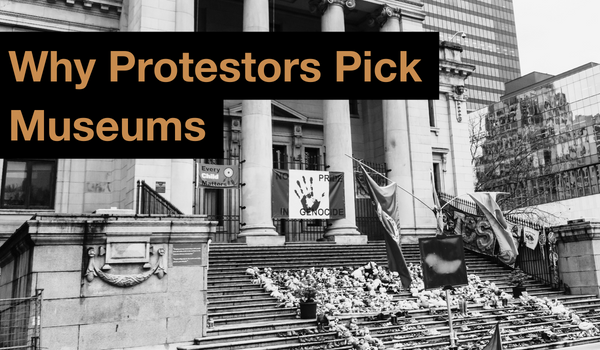In the News
In 2023, museums were constantly in the news as the sites of global protest for causes as diverse as armed conflict, food security, and climate change. Some months, there were almost daily reports of activists throwing substances at works of art, staging sit-ins where they glued or handcuffed themselves to pieces, or gathering around or inside museums to conduct rallies and protests.
Museum Protests Throughout History
To some, this uptick in reported incidents may seem unusual, but museums have long been favored sites for protest activity. They are open to public use, prone to trigger heavy news coverage due to the proximity to valuable art and artifacts, and often have a limited ability to respond due to restrictions or lack of security measures.
One of the earliest recorded incidents of museum protest occurred in 1914 when a suffragette named Mary Richardson slashed a Diego Velázquez painting titled The Toilet of Venus on display at the National Gallery in London.
Looking Ahead
The global security outlook in 2024 indicates no sign that these kinds of activities will be slowing down. Already this year, protesters have staged events at the Museum of Modern Art and the Brooklyn Museum in New York and thrown tomato soup at the Mona Lisa in Paris and red powder on the US Constitution in Washington, DC.
As physical and ideological conflicts continue to grow, and in a hotly contested election year for the US, these are unlikely to be isolated incidents.
How Museums Can Prepare for Protests
The 2024 outlook leaves little doubt that for many museums, it’s not a matter of whether protest activity will occur at their site but when. Here are some things to consider in preparing your museum to address these kinds of incidents safely:
- Train security not to allow protesters to publicize activities. Clear galleries to limit what is being filmed/posted so that real or perceived danger to the museum’s collection cannot become a hook to generate publicity.
- Press charges when necessary so that future protest/activist groups understand the consequences of behaving unsafely or causing harm.
- Coordinate your response plan with local police and other cultural properties in your area. Coordinate internally with staff responsible for security, visitor services, accessibility, collections care, and communications. A unified approach is the safest and strongest.
- Do not attempt to arrest or physically remove protesters. Wait for the police.
When museums are caught up in the currents of civil unrest, awareness and proper preparation can minimize any negative impacts without hindering their mission of engaging with their community.




